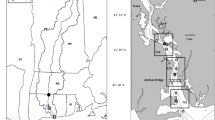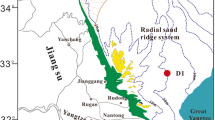Abstract
Data extracted from video recordings of individual estuarine flocs near the estuary bed during the advance and retreat of the salt intrusion show changes in size and settling velocity distributions. The recordings were taken using INSSEV —IN Situ SEttling Velocity instrument. Size coupled with effective density variations due to both changes in floc structure and ambient salinity result in changes in the settling velocity during the tidal cycle. In particular, just after high water slack, the appearance of high settling velocity medium size flocs and individual particles suggest that the lower density flocs have been broken up by the intense vertical shear in the currents caused by the salt wedge intrusion. Current shear is shown to have a significant influence on floc effective density.
Similar content being viewed by others
References
AL ANI, S., K.R. DYER and D.A. HUNTLEY, 1991. Measurement of the influence of salinity on floc density and strength. Geo-Mar. Lett., 11: 154–158.
ALLEN, T., 1975. Particle size measurement. Chapman and Hall, London.
BALE, A.J. and A.W. MORRIS, 1987.In situ measurement of particle size in estuarine waters. Estuar. Coast. Shelf Sci., 24: 253–263.
BARTZ, R., J.R.V. ZANEFELD, I.N. McCAVE, F.R. HESS and A.R.M. NOWELL, 1985. ROST and BEAST: devices forin situ measurement of particle settling velocity. Mar. Geol., 66: 381–395.
DYER, K.R., 1989. Sediment processes in estuaries: future research requirements. J. Geophys. Res., 94(C10): 14327–14339.
EISMA, D., T. SCHUHMACHER, H. BOEKEL, J. VAN HEERWAARDEN, H. FRANKEN, M. LANN, A. VAARS, F. EIJGENRAAM and J. KALF, 1990. A camera and image analysis system forin situ observation of flocs in natural waters. Neth. J. Sea Res., 27: 43–56.
FENNESSY, M.J., K.R. DYER and D.A. HUNTLEY, 1994. INSSEV: an instrument to measure the size and settling velocity of flocsin situ. Mar. Geol., 117: 107–117.
GIBBS, R.J., 1983. Coagulation rates of clay minerals and natural sediments. J. Sed. Petrol., 52: 1193–1203.
GRAF, W.H., 1971. Hydraulics of sediment transport. MGraw-Hill, New York.
HUNTER, K.A. and P.S. LISS, 1982. Organic matter and the surface charge of suspended particles in estuarine waters. Limnol. Oceanogr., 27: 322–335.
KINEKE, G.C., R.W. STERNBERG and R. JOHNSON, 1989. A new instrument for measuring settling velocitiesin situ. Mar. Geol. 90: 149–158.
KRANCK, K. and T.G. MILLIGAN, 1992. Characteristics of Suspended Particles at an 11-Hour Anchor Station in San Francisco Bay, California. J. Geophys. Res., 97(C7): 11373–11382.
LOVELL, C.J. and C.W. ROSE, 1991. The effects of sediment concentration and tube-diameter on particle settling velocity measured beyond Stokes' range: experiment and theory. J. Sed. Petrol., 61: 583–589.
McCABE, J.C., K.R. DYER, D.A. HUNTLEY and A.J. BALE, 1992. The variation of floc sizes within a turbidity maximum at spring and neap tides. Proceedings of 23rd International Conference on Coastal Engineering, Venice, p. 3178–3188.
McCAVE, I.N. and T.F. GROSS, 1991.In situ measurement of particle settling velocity in the deep sea. Mar. Geol., 99: 403–411.
MEHTA, A.J. and J.W. LOTT, 1987. Sorting of fine sediment during deposition. In Proceedings of Specialty Conference on Advances in Understanding of Coastal Sediment Processes (New Orleans), American Society of Civil Engineers, New York, p. 348–362.
OWEN, M.W., 1971. The effect of turbulence on the settling velocity of silt flocs. Proceedings of 14th Congress of International Association for Hydraulics Research, Paris, D4.1–D4.6.
PULS, W., H. KUEHL and K. HEYMANN, 1988. Settling Velocity of Mud Flocs: Results of Field Measurements in the Elbe and the Weser Estuary. In: J. Dronkers and W. Van Leussen, Eds., Physical Processes in Estuaries, Springer Verlag, Berlin Heidelberg, p. 404–424.
SPINRAD, R.W., R. BARTZ and J.C. KITCHEN, 1989.In Situ Measurements of Marine Particle Settling Velocity and Size Distributions using the Remote Optical Settling Tube. J. Geophys. Res., 94(C1): 931–938.
TEN BRINKE, W.B.M., 1993. The Impact of Biological Factors on the Deposition of Fine-grained Sediment in the Oosterschelde (The Netherlands), PhD Thesis, University of Utrecht.
UNCLES, R.J. and J.A. STEPHENS, 1993. Nature of the turbidity maximum in the Tamar Estuary, U.K. Estuar. Coast. Shelf Sci., 36: 413–431.
VAN LEUSSEN, W., 1988. Aggregation of particles, settling velocity of mud flocs: a review. In: J. Dronkers and W. Van Leussen, Eds. Physical Processes in Estuaries. Springer Verlag, Berlin Heidelberg New York, p. 347–403.
Author information
Authors and Affiliations
Rights and permissions
About this article
Cite this article
Fennessy, M.J., Dyer, K.R. & Huntley, D.A. Size and settling velocity distributions of flocs in the Tamar estuary during a tidal cycle. Netherlands Journal of Aquatic Ecology 28, 275–282 (1994). https://doi.org/10.1007/BF02334195
Issue Date:
DOI: https://doi.org/10.1007/BF02334195




